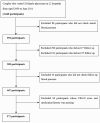Relationship between visit-to-visit blood pressure variability and depressive mood in Korean primary care patients
- PMID: 38714925
- PMCID: PMC11075231
- DOI: 10.1186/s12875-024-02404-6
Relationship between visit-to-visit blood pressure variability and depressive mood in Korean primary care patients
Abstract
Background: High blood pressure variability (BPV) increases the risk of cardiovascular disease and may be better prognostic factor than blood pressure. Depressive mood is a common symptom among patients visiting primary care. This study aimed to investigate the association between depressive mood and high BPV among Korean primary care patients.
Methods: The Family Cohort Study in Primary Care (FACTS), conducted from April 2009 to November 2017, utilized a prospective cohort of Korean primary care patients, with a median follow-up period of 7.25 years. Depressive mood was assessed as a score of 21 points or more on the Korean-type Center for Epidemiologic Studies Depression scale. BP was measured at the initial visit and first and second follow-up visit. Visit-to visit SBP variability was analyzed using four metrics: intra-individual standard deviation, coefficient of variation, variation independent of mean, and average real variability. Logistic regression analysis was used to estimate the association of high BPV with depressive mood and other variables.
Results: Among 371 participants, 43 (11.6%) had depressive mood based on depression scores. Older age (odds ratio [OR]: 1.04, 95% confidence interval [CI]: 1.01-1.07) were associated with high SBP variability regardless of taking antihypertensive medication. Among participants taking antihypertensive medication, those with depressive mood had twice the risk of high SBP variability compared with those who did not (OR: 2.95, 95% CI: 1.06-8.20).
Conclusions: Depressive mood was associated with high visit-to-visit SBP variability in primary care patients taking antihypertensive medication, potentially indicating increased cardiovascular risk. Primary care physicians should therefore closely monitor BPV in patients with depressive symptoms and provide appropriate interventions.
Keywords: Blood pressure; Blood pressure variability; Depressive mood; Primary care; Visit-to-visit blood pressure variability.
© 2024. The Author(s).
Conflict of interest statement
The authors declare no competing interests.
Similar articles
-
Visit-to-visit blood pressure variability is common in primary care patients: Retrospective cohort study of 221,803 adults.PLoS One. 2021 Apr 2;16(4):e0248362. doi: 10.1371/journal.pone.0248362. eCollection 2021. PLoS One. 2021. PMID: 33798213 Free PMC article.
-
Number of blood pressure measurements needed to estimate long-term visit-to-visit systolic blood pressure variability for predicting cardiovascular risk: a 10-year retrospective cohort study in a primary care clinic in Malaysia.BMJ Open. 2019 Apr 20;9(4):e025322. doi: 10.1136/bmjopen-2018-025322. BMJ Open. 2019. PMID: 31005918 Free PMC article.
-
Within-visit and between-visit intra-individual blood pressure variability in an unselected adult population from rural China.J Hypertens. 2021 Jul 1;39(7):1346-1351. doi: 10.1097/HJH.0000000000002810. J Hypertens. 2021. PMID: 33967241
-
Effects of Antihypertensive Therapy on Blood Pressure Variability.Curr Hypertens Rep. 2016 Oct;18(10):75. doi: 10.1007/s11906-016-0680-3. Curr Hypertens Rep. 2016. PMID: 27699587 Review.
-
Approaches for Evaluating Visit-to-Visit Blood Pressure Variability as a Cardiovascular Disease Risk Factor: A Scoping Review.Stud Health Technol Inform. 2024 Aug 22;316:349-353. doi: 10.3233/SHTI240417. Stud Health Technol Inform. 2024. PMID: 39176745
Cited by
-
Closer look at the cardiovascular and metabolic predictors of postpartum depression.World J Psychiatry. 2025 Jun 19;15(6):106283. doi: 10.5498/wjp.v15.i6.106283. eCollection 2025 Jun 19. World J Psychiatry. 2025. PMID: 40574759 Free PMC article.
References
Publication types
MeSH terms
Substances
Grants and funding
LinkOut - more resources
Full Text Sources
Medical
Miscellaneous

